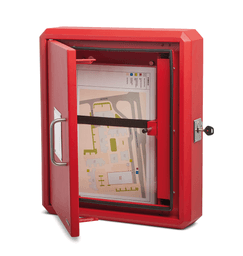Fire Safety in Specialised Housing: A Comprehensive Guide
Ensuring fire safety in specialised housing is a vital responsibility. These environments, which include sheltered housing, extra care housing, and supported living facilities, cater to residents who may have reduced mobility, cognitive challenges, or other vulnerabilities. At Gerda Security, we specialise in providing solutions that ensure safety, regulatory compliance, and peace of mind for all… Continue reading Fire Safety in Specialised Housing: A Comprehensive Guide
Ensuring fire safety in specialised housing is a vital responsibility. These environments, which include sheltered housing, extra care housing, and supported living facilities, cater to residents who may have reduced mobility, cognitive challenges, or other vulnerabilities. At Gerda Security, we specialise in providing solutions that ensure safety, regulatory compliance, and peace of mind for all stakeholders in these types of specialised housing.
This guide provides an in-depth look at fire safety principles, strategies and solutions, including the importance of FD30(S) fire doorsets. Let’s explore how we can create safer spaces by improving fire safety in sheltered housing.
Key Takeaways
- ‘Specialised housing’ includes accommodation options like sheltered and extra care housing, designed for vulnerable individuals.
- Key fire safety measures: Early warning systems, tailored evacuation plans, and robust compartmentation.
- Gerda FD30(S) fire doorsets offer enhanced fire resistance, smoke control, and digital traceability.
- Collaboration among commissioners, housing providers, and care providers is critical for success.
Understanding Specialised Housing and Its Fire Safety Needs
Specialised housing encompasses several accommodation types:
- Sheltered housing: For older adults needing minimal supervision.
- Extra care housing: Includes on-site support for daily living.
- Supported housing: Designed for individuals with learning disabilities, mental health issues, or physical impairments.
These environments often house individuals who may face challenges in recognising or responding to fire emergencies. For this reason, fire safety measures must be tailored to address these specific needs.
The Foundations of Fire Safety in Specialised Housing
Person-Centred Fire Safety
A person-centred approach to fire safety considers:
- Residents’ mobility and cognitive abilities.
- Behaviours, such as smoking or using mobility aids, that might elevate fire risks.
- Custom solutions like visual alarms for hearing-impaired residents.
Key Safety Features
Effective fire safety relies on several core principles:
- Early Detection Systems: To facilitate early detection, smoke and heat alarms should be installed throughout the premises, with remote monitoring where possible.
- Compartmentation: Flats and individual units built as fire-resisting compartments prevent fire from spreading quickly.
- Tailored Evacuation Strategies: Fire evacuation and other emergency response plans should account for residents who require assistance or are unable to self-evacuate.
Learn more about fire safety solutions for communal areas here.
Advanced Fire Protection Measures
Smoke and Heat Detection
Modern fire safety systems rely on extensive smoke and heat detectors, often integrated with remote monitoring for faster emergency response. These systems are frequently used to improve fire safety in sheltered housing.
Gerda FD30(S) Fire Doorsets
A cornerstone of fire protection is the installation of certified fire doorsets. The Gerda FD30(S) fire doorset offers:
- 30+ minutes of fire resistance.
- Smoke control, ensuring safe evacuation routes.
- Digital traceability via the G-Smart™ app, which simplifies maintenance.
These doorsets comply with the latest building regulations and provide environmentally friendly solutions for housing providers. Learn more about their history and importance in our blog post on FD30 fire doorsets.
Developing and Implementing Fire Risk Assessments
Person-Centred Risk Assessments
Conducting a fire risk assessment is the first step in identifying vulnerabilities:
- Identify High-Risk Residents: As an example, focus on those with mobility challenges or sensory impairments.
- Customise Protection Measures: Install visual alarms, fire barriers, and suppression systems where necessary.
- Engage Residents: Regularly educate residents on fire safety protocols.
Shared Responsibilities for Fire Safety
Fire safety in specialised housing requires collaboration among key stakeholders:
- Commissioners: Responsible for funding and policy oversight.
- Housing Providers: Ensure compliance with structural safety regulations.
- Care Providers: Assist with day-to-day safety practices and evacuation planning.
Clearly defined and documented responsibilities between these parties are essential to prevent gaps in safety.
Evacuation Strategies in Specialised Housing
Stay-Put vs. Simultaneous Evacuation
The precise evacuation strategies employed will depend on the building, but in general strategies fall into one of two categories:
- ‘Stay Put’ Strategies: Residents remain in fire-resistant compartments while fire services address the issue.
- ‘Simultaneous Evacuation’ Strategies: Also known as ‘one out, all out’, these strategies are recommended (if not outright required) for shared group homes or buildings without sufficient compartmentation.
Role of Fire Services
Early engagement with fire and rescue services is critical. Housing providers should:
- Share building layouts and fire safety features.
- Consider the use of Gerda PIBs and our ERP services to ensure that FRS have access to all the information they need in an emergency, and that it is stored securely.
- Conduct joint evacuation drills to ensure preparedness.
The Environmental and Community Benefits of Gerda Solutions
Gerda Security emphasises sustainable practices by using environmentally friendly materials in the construction of fire doorsets. Beyond safety, this approach also supports a greener future.
Frequently Asked Questions
What is specialised housing?
Specialised housing refers to accommodations for individuals with specific needs, such as older adults or people with disabilities.
How does compartmentation improve fire safety?
Compartmentation creates fire-resistant barriers, slowing the spread of fire and allowing safe evacuation.
Why are FD30(S) fire doorsets important?
FD30(S) doorsets provide 30+ minutes of fire resistance and smoke control, critical for ensuring safe evacuation routes.
Who is responsible for fire safety in specialised housing?
Fire safety is a shared responsibility among commissioners, housing providers, and care providers, with clear documentation of roles.
With tailored measures, collaborative efforts, and innovative solutions like the Gerda FD30(S) fire doorset, specialised housing providers can effectively safeguard their residents. Explore our Bognor Hostel & Hub case study to see our solutions for specialised housing in


